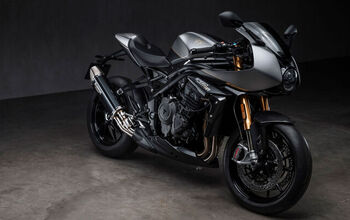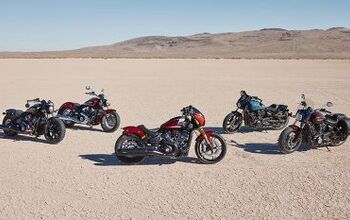Honda CB650R Vs. Husqvarna Svartpilen 701
Brothers from another mother?
Generally speaking, finding bikes to pair up for comparison is a bit more direct; throwing the R6 against the CBR600, or building out our adventure bike shootout is mostly a no-brainer, but sometimes bikes that roll through for testing end up revealing unexpectedly similar personalities. Late this past year, I faced exactly that. Both the Honda CB650R and Husqvarna Svartpilen 701 found their way into my driveway from their respective manufacturers at the same time (due to poor scheduling and limited availability of the Svart, more than anything), and I instantly found myself playing a game of spot the similarities.
The Basics
Yes, it helped that both test bikes showed up in black paint, but there’s way more to the equation than that. Their sticker prices are only a few hundred dollars apart, with the ABS-equipped CB650R at $9,199 and the Svartpilen 701 (with standard ABS) currently priced at $9,499 (thanks to a $2,500 price drop). Their displacement is a modest 43.7cc apart (surprisingly the 701 is actually a 692.9cc Single), however, we can’t look at comparing their horsepower and torque stats directly – Honda presently isn’t listing figures for their inline 4-banger. Of course, the power delivery from Husqvarna’s big thumper is actually very different than that of the Honda mill, but as far as where they stack up in the general performance food chain is once again close enough to make them competitors.
Further to the point, though different in some respects, these two bikes are pointed squarely at the same rider in terms of market position. They’re upright enough to not be abusive when riding more than an hour or two, yet with a distinct lack of wind protection, they’re also very much pointed at the more urban/commuter crowd. While the CB650R draws its neo-vintage aesthetics from the old-school CB400, the Svartpilen has its own retro-futurist vibe going on, seemingly derived from early flat-trackers and scramblers (albeit with a low-slung pipe and tire-hugging fender). Once seated you’ll immediately notice the ergos of the Svart feel like you’re sitting on something that’s meant to handle a bit of dirt. It’s a touch more upright than the Honda, and its bars are a modest amount wider. On that topic, there’s a bit more space from seat to peg on the Husqvarna, which at 6’1 is always welcome.
The Ride
From the initial firing of both engines, little time is wasted in spotting (and feeling) the differences between the duo of neo-retro streetfighters. From idle, there’s the distinct and obviously expected difference in smoothness between the pair. Much as Husqvarna has put work into smoothing out the brutish single, there’s no matching Honda’s buttery smooth mill – but that’s ok. Running a pair of counterbalance shafts in its internals, the Svartpilen isn’t near as vibey as you might imagine, and other than one instance of being pinned down in Toronto rush hour without the legal ability to lane split, it never reached a point of annoyance or irritation. In trade, the torquey nature of this powerplant, combined with the fact that the Svart has a roughly 80-pound weight advantage, promptly reveals a playful personality. As John Burns noted in his first ride review, getting the traction control switched off takes some fussing, but once you get there, the Svart makes no fuss about lifting a wheel as you grab some throttle.
The combination of low weight, a narrow frame, and wide bars makes it beautifully flickable, further adding to its fun factor when ripping around town. Its suspension is quite well mannered, with ample travel and full adjustability – something that can’t be said for the Honda, whose suspension only has rear preload adjustment.
As I talk up the fun, playful nature of the Svart, it’s hard not to think of the CB650R as a bit boring by comparison. There’s absolutely nothing wrong with the CB; it’s a very capable, smooth, and comfortable middleweight that’s easy to log miles on, but it is clearly the more subdued of the pair. More sport-focused riders will appreciate its slightly more tucked riding position, lower bars, and slightly higher stability on highways. It’s still a light bike overall, but the difference between the two bikes was definitely noticeable when coming up against tractor-trailers doing north of 60 mph. At highway speeds, you’ll also note a dramatic difference in gearing between the two bikes. The Honda’s gears are all quite short, leaving you revving well into the midrange once you’re at cruising speed, whereas the Svartpilen has an extremely tall 6th, whose sole purpose is low-rev highway cruising. It’s worth noting that both bikes have a quick-shift function, both of which work just fine.
The Little Details
Continuing down this path of “similar but different,” there’s some more overlap in terms of features on both the CB650R and the Svart. Both use a compact fully digital instrument cluster – round on the Svart and rectangular on the Honda. As cool as the Svart’s cluster looks, from a functional standpoint, the Honda easily wins out here, as information is clearer, brighter, and easier to absorb at a quick glance. Speaking of brighter, the Honda could use a bit of a bump in light output for night rides. Though both bikes use a single-can light setup, the Husqvarna’s headlight is definitely the stronger of the pair.
From a design standpoint, things get a bit subjective here. As far as overall cohesive design goes, I’m surprised to say that I’m going to hand it to Honda. It ticks all the boxes of a sleek naked bike with hints of vintage character (without trying too hard to be a “retro bike”). The Husqvarna, on the other hand, has a ton of clever details to its design, but overall I can’t help but have the word quirky comes to mind every time I look at it. The big 5-spoke wheels (thankfully swapped out for wire wheels in 2020) are just awkward, as is the design of its fuel tank. The ‘cut line’ that runs straight front mounting point of its seat through to its exhaust bracket is a really clever touch, but even that splits up the side profile of the bike in a peculiar fashion. Lastly, its rear fender and low license plate mounting is a failed afterthought that desperately begs for a (fortunately available) tail tidy. Granted the tail on the CB650R is near equally tragic.
In The End
At the end of the day, if it were my hard-earned dollars going out the door, it would be hard for me not to land in the Husqvarna camp. As noted, the Honda is a good bike, a smooth bike, a competent bike, but there’s something to the quirkiness, awkwardness, and the big dumb fun factor of the Svartpilen 701 that immediately captured my attention. If you’ve had any dirt experience in your riding background you’re likely to follow me into the Swede’s camp, though if you’re a pavement rider through-and-through the cool conventions of the Honda might be more your speed. It’s one of those things. You either get and appreciate quirky/weird/different things, or you don’t. Either way both of these bikes are still money well spent.
2020 Honda CB650R | 2020 Husqvarna Svartpilen 701 | |
|---|---|---|
| MSRP | $9,199 | $9,499 |
| Engine Type | 649cc liquid-cooled inline Four-cylinder DOHC, four valves per cylinder | 693cc liquid-cooled Single cylinder, SOHC, four valves per cylinder |
| Bore and Stroke | 67mm x 46mm | 105 x 80 mm |
| Compression Ratio | 11.6:1 | 12.8:1 |
| Transmission | 6-speed; wet multi-plate clutch | Close ratio 6-speed, slip/assist hydraulic clutch, quickshifter up and down |
| Final Drive | Chain | Chain |
| Front Suspension | 41mm inverted Showa Separate Function Fork (SFF); 4.72 inches of travel | 43mm inverted WP fork with spring preload, rebound and compression damping adjustability; 4.9 inches of wheel travel |
| Rear Suspension | Showa single shock w/adjustable preload; 5.04 inches of travel | Single linkage-type shock with spring preload, rebound and compression damping adjustability; 4.9 inches of travel |
| Front Brake | Dual four-piston radial mount Nissin hydraulic calipers with 310mm floating discs, 2 channel ABS | Floating 320mm disc, Brembo 4-piston caliper, Bosch 9M ABS |
| Rear Brake | Single one-piston hydraulic caliper w/240mm disc, 2 channel ABS available | 240mm disc, 1-piston caliper, Bosch 9M ABS |
| Front Tire | 120/70-17 | Pirelli MT60 RS 110/80 R18 |
| Rear Tire | 180/55-17 | Pirelli MT60 RS 160/60 R17 |
| Rake/Trail | 30.0 deg/4.0 in | 25 deg/4.7 in (119 mm) |
| Wheelbase | 57.0 inches | 56.5 inches (1436 +/- 15 mm) |
| Seat Height | 31.9 inches | 32.9 inches (835 mm) |
| Curb Weight | 445 pounds (claimed) | 349 pounds (claimed, no fuel) |
| Fuel Capacity | 4.1 gallons | 3.2 gallons |
| Colors | Chromosphere Red | Gray |
More by Justin Mastine-Frost











































Comments
Join the conversation
Thanks for this comparison. These two bikes are exactly the two bikes my son is looking at. He see's them in the same "café" category and its the size he wants as a guy just moving up from a learner bike.
The fartpiler needs a makeover. That is one butt ugly bike.